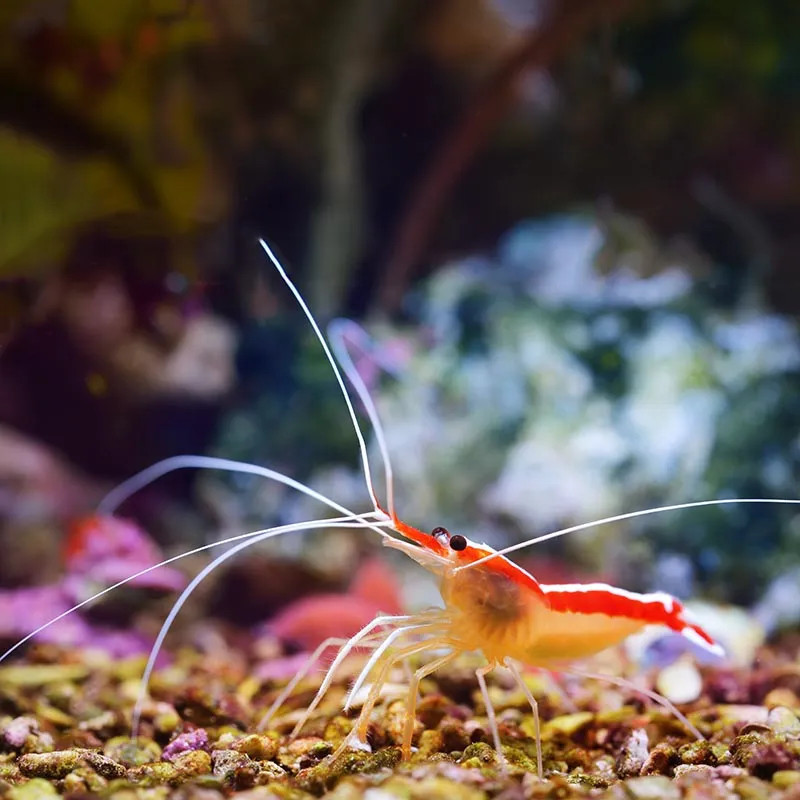Out of stock
SCARLET SKUNK CLEANER SHRIMP M
SKU:225943
LYSMATA AMBOINENSIS
1.25-1.75 INCH

Stock Available
Introduction: • Species: Cleaner Shrimp • Common Names: Skunk Cleaner Shrimp, Scarlet Cleaner Shrimp, Pacific Cleaner Shrimp • Natural Habitat: Found in coral reefs throughout the Indo-Pacific region, often seen setting up "cleaning stations" where fish come to be cleaned. Physical Characteristics: • Appearance: Recognized by their bright red bodies with a bold white stripe running from the head to the tail, along with long, white antennae. • Size: Typically grows up to 2 inches (5 cm) in length. • Lifespan: Can live up to 2-3 years in captivity with proper care. Habitat Requirements: • Tank Size: A minimum of 10 gallons, although a larger tank is preferred for more stability. • Water Conditions: o Temperature: 72-80°F (22-27°C). o pH: Maintain a pH level of 8.0-8.4. o Salinity: Optimal salinity should range between 1.023 and 1.025. • Aquascaping: Provide plenty of hiding places, such as live rock and caves, where they can retreat and molt safely. Diet: • Primary Diet: Cleaner Shrimp are omnivorous, feeding on parasites and dead tissue they pick off fish in the wild. • Supplemental Feeding: In captivity, they can be fed small meaty foods like brine shrimp, mysis shrimp, and finely chopped seafood. • Feeding Frequency: Feed them 2-3 times per week, in addition to what they scavenge from the aquarium. Compatibility: • Temperament: Peaceful and beneficial, often seen interacting with fish by cleaning them of parasites. • Suitable Tank Mates: Works well in a community tank with peaceful fish species, including tangs, clownfish, and gobies. • Incompatibilities: Avoid housing them with predatory fish, such as large wrasses and groupers, which may eat the shrimp. Care Level: • Difficulty: Easy to moderate; suitable for beginner aquarists as long as water conditions are stable. • Health Monitoring: Monitor for stress during molting periods and ensure they have adequate iodine levels in the water to aid in successful molts. Breeding: • Breeding in Captivity: Possible, as Cleaner Shrimp are hermaphrodites. Two individuals will fertilize each other’s eggs. • Spawning: After fertilization, the shrimp carry green eggs under their abdomens until they hatch into larvae. Raising the larvae is challenging, as they require specialized care and food. Economic Considerations: • Market Demand: High demand due to their peaceful nature and cleaning behavior, making them popular in reef tanks. • Wholesale Pricing: Generally affordable, though prices may vary depending on size and location. • Retail Pricing: Typically falls within the moderate price range in local and online stores. Sustainability and Conservation: • Wild Population: Cleaner Shrimp populations are generally stable, though some collection areas may face localized depletion. • Aquaculture Efforts: Captive breeding is increasing, reducing the need for wild-caught specimens. • Regulations: Follow local and international regulations when purchasing to ensure sustainability in the trade. Conclusion: The Cleaner Shrimp is an excellent addition to marine aquariums, known for its beneficial cleaning behavior and peaceful disposition. Easy to care for and visually striking, they are a great choice for both beginner and experienced aquarists. Their ability to help keep tank inhabitants healthy by removing parasites makes them a functional and fascinating member of a reef community.
Data sheet
2 other products in the same category:
Customers who bought this product also bought: